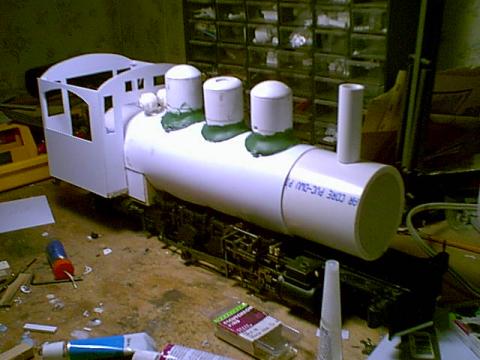 Well train fans, we’re back with a another installment of the Bachmann Bash. This time taking a look at putting together the firebox, cab deck, cab subwalls, and most importantly the domes!
Well train fans, we’re back with a another installment of the Bachmann Bash. This time taking a look at putting together the firebox, cab deck, cab subwalls, and most importantly the domes!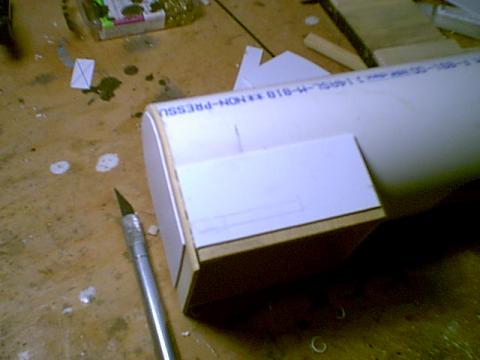 The firebox was really simple to do. I cut the sides out of wood, tapered them to the boiler and glued them in place. Then I traced the outine of the rear of the boiler and cut that out from the same piece of 1/8 inch poplar.
The firebox was really simple to do. I cut the sides out of wood, tapered them to the boiler and glued them in place. Then I traced the outine of the rear of the boiler and cut that out from the same piece of 1/8 inch poplar.
Once it was glued in place, it was pretty strong. This fireboxjust sorta slides down over the old Bachmann one which is paret of the chasiscasting.
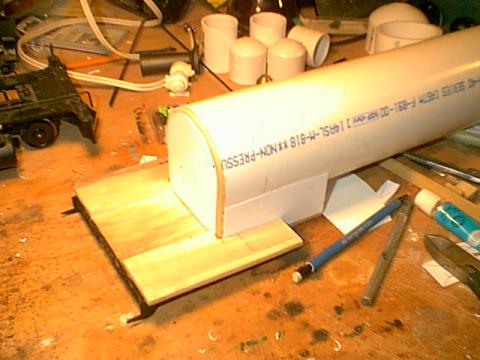 Now its time to focus on the cab deck. I cut it out of 1/8 poplar as well, centering it on the boiler and giving it the proper indentation to accomodate the cab and the trailing truck. As you can see it does have a bit of a step up off the main deck to the area where the seatboxes will be.
Now its time to focus on the cab deck. I cut it out of 1/8 poplar as well, centering it on the boiler and giving it the proper indentation to accomodate the cab and the trailing truck. As you can see it does have a bit of a step up off the main deck to the area where the seatboxes will be.
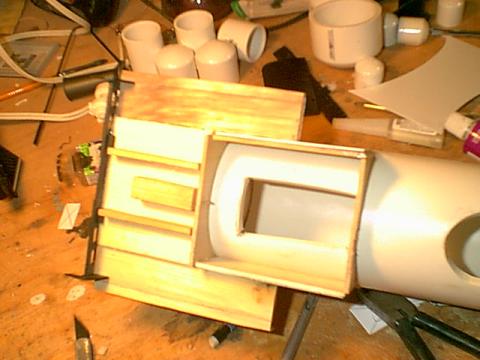 In this photo you can see the basic framework that was applied, its not highly detailed because its out of sight for the most part what is there was to help keep the cab deck level with the boiler. The large block in the center of the deck holds a nail as well that fits into the rear of the firebox. The tolerances are such that its a nice snug fitwith a little glue to hold it all in place. Here you can see up inside the firebox. The square hole in the PVC boiler slips over the top of the Bachmann firebox to allow the boiler to sit lever on the chasis, the round hole to the right allowsthe motor and gear box to slip up inside. The internal weights havn’t been applied at this point. The plan is to us some square or hex bolts through the new firebox sides into the old one to hold the rear of the boiler in place. These will then be disguised as washout plugs!
In this photo you can see the basic framework that was applied, its not highly detailed because its out of sight for the most part what is there was to help keep the cab deck level with the boiler. The large block in the center of the deck holds a nail as well that fits into the rear of the firebox. The tolerances are such that its a nice snug fitwith a little glue to hold it all in place. Here you can see up inside the firebox. The square hole in the PVC boiler slips over the top of the Bachmann firebox to allow the boiler to sit lever on the chasis, the round hole to the right allowsthe motor and gear box to slip up inside. The internal weights havn’t been applied at this point. The plan is to us some square or hex bolts through the new firebox sides into the old one to hold the rear of the boiler in place. These will then be disguised as washout plugs!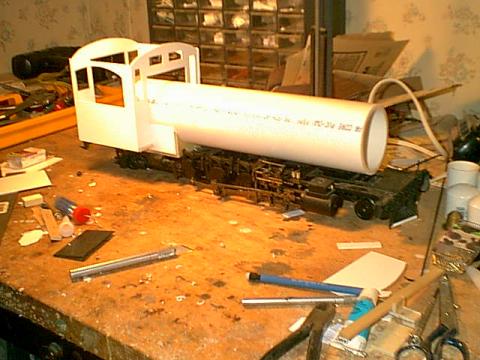 Now her lines are starting to become apparent. with the boiler sitting on the chasis and cab deck in place, I was able to take some basic measurements. I used a CAD program to draw out the front, sides and rear and printed them out on cardstock. Cardstock is great fer templates such as this, its more durable than paper and easier to trace because it doesn’t bend or tear as easily while cutting and tracing, but its thin and light enough to run through the average printer.
Now her lines are starting to become apparent. with the boiler sitting on the chasis and cab deck in place, I was able to take some basic measurements. I used a CAD program to draw out the front, sides and rear and printed them out on cardstock. Cardstock is great fer templates such as this, its more durable than paper and easier to trace because it doesn’t bend or tear as easily while cutting and tracing, but its thin and light enough to run through the average printer. 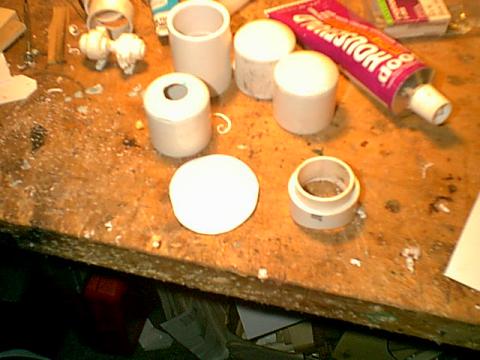 Now its dome time. I use rounded plumbing caps (1 inch fittings in this case) for dome construction. the base of the dome is taken from a coupling, I shape the bottom to fit the contour of the boiler thencut the piece off on the bandsaw. I thne use it to trace out a baseplatefor the dome and glue it on the bottom, leaving an 1/4 inch or so to allowfor a taper. I use a short section of 1inch PVC pipe as a coupling and glue it inside the base. The upper part of the sand domes are pretty much stock, just sanded to remove the cast in lettering on them. I did spin them on the bandsaw to give them the appearance of having a parting line in the sheet metal. On the steam dome I sliced the top off and used the resulting hole for the whistle and pop valves to mount in later.
Now its dome time. I use rounded plumbing caps (1 inch fittings in this case) for dome construction. the base of the dome is taken from a coupling, I shape the bottom to fit the contour of the boiler thencut the piece off on the bandsaw. I thne use it to trace out a baseplatefor the dome and glue it on the bottom, leaving an 1/4 inch or so to allowfor a taper. I use a short section of 1inch PVC pipe as a coupling and glue it inside the base. The upper part of the sand domes are pretty much stock, just sanded to remove the cast in lettering on them. I did spin them on the bandsaw to give them the appearance of having a parting line in the sheet metal. On the steam dome I sliced the top off and used the resulting hole for the whistle and pop valves to mount in later.
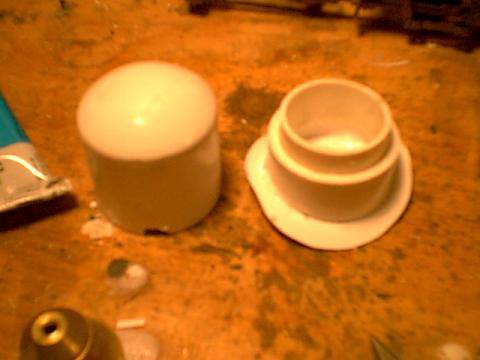 The dome is almost done in this view, I did make a notch for the sanding valve lever to protrude through. Below the dome has been addred to the base and block of styrene has been glued in place on either side to allowfor the sand lines coming out of each dome.
The dome is almost done in this view, I did make a notch for the sanding valve lever to protrude through. Below the dome has been addred to the base and block of styrene has been glued in place on either side to allowfor the sand lines coming out of each dome.
 Thats all for this installment. with the domes in place, she’s definately starting to look like a locomotive. Tune in next time for mor bashing debauchery!!
Thats all for this installment. with the domes in place, she’s definately starting to look like a locomotive. Tune in next time for mor bashing debauchery!!
